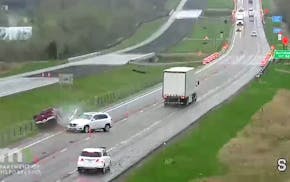It was 20 years ago that state public safety officials launched the Toward Zero Deaths (TZD) program to reduce crashes resulting in fatalities and serious injuries.
The initiative proved to be one of the most successful in the nation as highway deaths in Minnesota dropped from just under 700 in 2003 to half that a decade later.
But over the past 10 years, traffic deaths have largely plateaued, and in recent years have spiked as drivers drove faster and were impaired more often.
"The pandemic wiped out all the gains we made," said Mike Hanson, director of the the state Department of Public Safety's Office of Traffic Safety.
In a push to give TZD a reset, Hanson and the DPS asked the Legislature to invest in traffic safety. And lawmakers came through with $2 million to fund the newly created Advisory Council on Traffic Safety.
"This is state money we never had before," Hanson said, noting that TZD has been funded with federal money, which came with specific purposes and directives on how to spend it. "State money will let us do things federal dollars didn't let us do."
What that exactly entails will be fleshed out as the council holds its second meeting later this fall. The group met for the first time two weeks ago.
But there is a framework to guide the council's 33 members representing agencies such as the Minnesota Department of Transportation, the State Patrol, the Minnesota Safety Council, Minnesota Trucking Association, Operation Lifesaver, DPS, and the state Health Department.
The group is charged with advising the governor and commissioners of public safety, transportation and health on policies, programs and services affecting traffic safety. The council also will encourage state agencies to conduct research in areas of traffic safety, review traffic safety grants and state and local traffic safety plans, and keep departments across the state abreast of TZD programs and activities.
Minnesota recorded 444 traffic deaths last year, the most since 2008. This year traffic deaths are trending down with 294 as of Wednesday compared with 341 at the same time a year ago.
Still, "one is too many," Hanson said. "When you look at the causes of motor vehicle crashes, most are due to human error. We can change human behavior with education to make smarter and better decisions."
Minnesota is still one of the safest states for drivers, but Hanson said the council will be searching for new and creative ways to reach motorists through outreach, training and engagement to encourage safe driving and raise public awareness.
Hanson said the public can play a role, too. All meetings with in-person and online attendance will include time for public comment.
"If you are concerned about traffic safety in your city, your neighborhood or in Minnesota, reach out to us," Hanson said. "We need to find a solution that we have not found yet and get back to the steep decline [in deaths]."

A reporter and her child navigate a Minnesota rite of passage: a ropes course
I-35W northbound closed in Bloomington after crash involving pedestrian

This ancient tree is one of the oldest in Minnesota. The warming climate might kill it.

